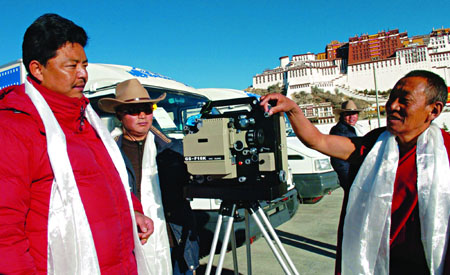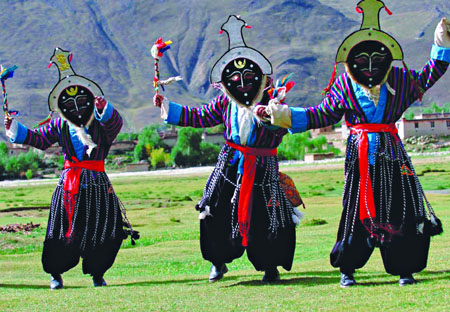| In 2006, mass literary and art workers in Tibet produced a large number of programs enjoying public popularity. Of the total, in the Third Minority Art Festival of China, the large song and dance gala, Colorful Hada gained the gold award among music and dance works, the Tibetan delegation won the award of "Outstanding Organizer", some programs were granted the "Excellent Program Award" and seven members won the "Excellent Player Award" and "Award for Best Young Actor and Actress". By the end of 2006, the TAR had 25 professional art performing groups, 208 cultural centers, four public libraries and two museums.
Radio, TV and Network
In recent years, Tibet has practically improved the audio-visual cultural life of farmers and herders. At the end of 2006, the region had three radio stations, 38 short and medium wave broadcasting transmitting stations and five TV stations, with the radio and TV coverage rate reaching 85.8 percent and 86.9 percent respectively, basically realizing the target of extending broadcasting coverage to each administrative village.

Tibet undertaks the programs geared to show film once a month for each village and make all villagers have access to radio and TV programs. This helps improve the cultural life of the farmers and herders. Picture shows projectionist making preparation for a movie show.
Furthermore, by the end of 2006, the number of internet subscribers in Tibet stood at 160,000, accounting for 5.8 percent of the population; compared with January 2004, this represented an increase of 74,000. With regard to the location of website domain name registering units, the number of Tibetan domain names hit 2,440, compared to 1,616 in 2004.
Press and Publication
In 2006, centering on the key selected topics such as tourism, Tibetan doctors and medicines Tibetan handicrafts and animals and plants on the plateau, the press and publication department of Tibet realized sustainable, fast, healthy and orderly development. Tibet published 42.08 million newspapers prints, 2.68 million copies of magazines and 9.28 million copies of books in the year, with the total output value hitting 310 million Yuan, accounting for 1.25 percent of Tibet's GNP.
In December 2006, the project of compiling the first punctuated Buddhist sutra, Tripitaka, was launched. The book A New Edition of Tripitaka in Chinese with 300 million characters and 300-plus volumes not only played a key role in the development of Buddhism, but also exerted far-reaching impact in many fields such as philosophy, history, nationality, language, literature, art and astronomy. Its contents are double that of the Japanese Taisho Tripitaka, with the most complete varieties of sutras.
Tibetan Studies
Old Tibet had no Tibetan studies in the modern sense. But, today, Tibetology has become a grand system of comprehensive studies of Tibetan society. According to statistics, there are over 60 institutions of Tibetan studies and more than 1,000 experts and scholars in this field in China at present. It covers most of the basic subjects in the social and natural sciences, including culture, Tibetan medicine and pharmacology, transportation and tourism. Great progress has been made in Tibetan studies in Tibet. The increasingly strengthened Tibetology will exert profound influence upon the Tibetan society, culture, and the protection and development of medicine. In 2006, China offered the first State-level award-Mount Qomolangma Award-for Tibetan studies, marking the beginning of the brand-new stage in the development of China's Tibetan studies cause. Starting from 2007, China's Tibetan studies will translate the important works on Tibetan into English.
Protection of Cultural Relics
Tibet is one of the provincial-level regions in China richly endowed with historical and cultural relics. A rough calculation shows that there are more than 2,000 cultural relics sites in the region. They include 35 subject to national protection, 48 to regional protection and 96 to prefectural and county level protection. Lhasa City, Xigaze City and Gyangze county seat are rated by the PRC State Council as national historical and cultural cities subject to special protection. And the Potala Palace, Jokhang Monastery and Norbu Lingka have been listed as UNESCO World Cultural Heritage sites. The past 20 years saw investment of over 600 million Yuan by the State effectively protecting the important historical and cultural heritage of Tibet.
In 2006, Tibet continued to implement the policy of "putting protection and rescue first, rational utilization and strengthening management" which guaranteed the healthy development of cultural relic undertakings. Of the total, the project for protection of the three cultural relics namely Potala Palace, Norbu Lingka and Sagya Monastery went smoothly. Among the 11 sub-items started that year, nine were completed, with an investment of 17 million Yuan. So far, some 154 sub-items of the project have been launched, 111 of which were completed and passed inspection, with an investment of 222.72 million Yuan, accounting for 67 percent. In addition, remarkable achievements were also made in the aspects of renovation of the surrounds of the Potala Palace, investigation of cultural relics along the section of the Qinghai-Tibet Railway in Tibet and construction of the laws and regulations concerning cultural relics, such as registration, archives construction and fire control, and so on.
In May 2006, in the list of the sixth group of key cultural relics units subject to national protection, eight sites and nine spots in Tibet were added. Hence, the number of cultural relics units subject to national protection in Tibet stood at 35.
Intangible Cultural Heritage
Since 1980s, the TAR and each prefecture and city under it have set up institutions to rescue, rearrange and study the ethnic cultural heritage, and sent out investigation groups successively to make comprehensive investigations and conduct interviews in the urban areas, villages and temples. By the end of 2006, the staff members had interviewed more than 10,000 person times of folk handicraftsmen, transcribing large quantities of audiovisual materials and taking over 10,000 pictures. In addition, they published over 1,000 academic papers regarding the traditional culture of Tibetan ethnic group and brought out 30-plus works on the ethnic culture research. Tibet compiled the catalogue of the first group of intangible cultural heritage at autonomous region level, totaling 38 items in 2006.
In May 2007, the second group of 83 items was designated, including Mantsikhang Tibetan Hospital, the Astronomical Calendar, and so on. Those were selected from more than 130 items submitted, divided into 10 kinds such as folk music, folk dance and folk handicrafts.

Farmers from Namling County in southern Tibet performing Tibetan opera
In future, Tibet will work to establish the system for intangible cultural heritage protection and development, fully implementing projects concerning the protection and construction of intangible cultural heritage. Efforts will also be made to conduct the general survey work regarding intangible cultural heritage and set up archives and databanks. On such a base, Tibet will also make efforts to establish the system of classified protection, gradually, strengthening research, cognizance, preservation and inheritance work.
Foreign Cultural Exchanges
In 2006, Tibet increased its cultural exchanges with foreign countries. In February, two people were sent out with a group to take part in performances of Chinese artists held in Venice; in September, the folk song and dance troupe of the Qamdo area went to South Korea; from August to November, the China Tibet Cultural Relics Exhibition was successfully held in Essen of Germany.
On October 18-29, 2006, the "China Tibet Culture Week" was held in Austria, during which 200-odd pictures were exhibited. Some of them were selected from 150,000 works shot by some 100 photographers from 19 states, which represented politics, economy, culture and society of Tibet and the life of Tibetan people from various aspects. A total of 15 tangka were also showed, respectively reflecting the religion and medicine of Tibet and the history of the Tibetan ethnic group. In addition, the Tibet Qamdo Song and Dance Troupe performed the large-scale song-and-dance poem Magic Homeland in Austria, expressing the love of Tibetan people for life and nature and the wonderful longing for building a new, modern Tibet. Four Living Buddha's and scholars on Tibetan studies narrated real stories concerning Tibetan Buddhism and various ways of Tibet through academic reports and exchanges in discussion.
The "China Tibet Culture Week" has become an important way for Tibet to show its culture overseas. The first such week was held in Melbourne in 2001. Thus far, the week has been held in Australia, New Zealand, Canada, Belgium, Thailand, Denmark, Italy and Austria.
Besides the frequent overseas visits of Tibetan delegations, recent years also saw various localities and departments in Tibet receive visitors from some 20 countries and regions, and some 500 foreign officials, journalists and relative personnel in close to 100 groups. The cultural exchanges in an all-round way publicize and show the grandeur of Tibetan culture and the much headway made in the economic and social development of Tibet. |





